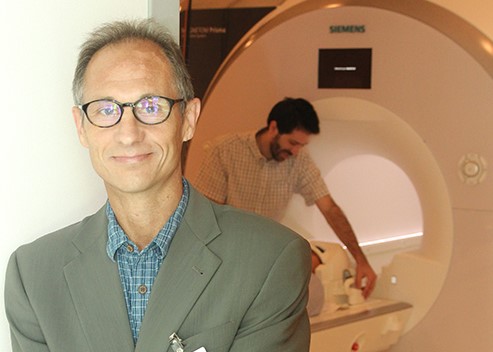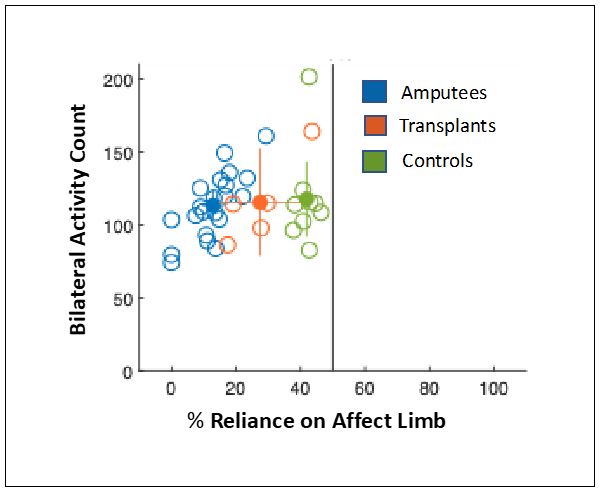Reconstructive Transplant Research
Improving and Quantifying Functional Hand Use in Hand Transplant Recipients and Amputees



Posted January 17, 2020
Scott Frey, Ed.M., Ph.D., The Curators of the University of Missouri, Columbia, Missouri

Extremity trauma and amputations represent a severe disease burden and cause a great degree of disability for both Service members and civilians. In Operations Enduring Freedom and Iraqi Freedom, it has been estimated that 54% of all combat wounds sustained were extremity injuries (1), while a query of the National Trauma Data Bank from 2009 – 2012 revealed that 46 per 100,000 trauma admissions underwent a major upper-extremity amputation (2). Treatment options for these life-altering events can include limb replantation, prosthetics, and for some, vascularized composite allotransplantation (transplantation of an intact hand or arm from a deceased donor).
It is understood that following limb loss, due to the reduction in activity-dependent signaling, a dramatic reorganization of the sensorimotor cortex of the brain occurs. Dr. Frey and his team at the University of Missouri, along with collaborators at Washington University in St. Louis and the University of Louisville, are investigating how transcranial direct current stimulation (tDCS) combined with behavioral training can be used to overcome injury-related reorganizational changes in the brain in order to improve functional recovery. tDCS is a safe, painless, and non-invasive method of modulating cortical excitability by placing electrodes on the scalp and passing a small current between them. When combined with constraint-induced movement therapy (CIMT), tDCS has been shown to be efficacious in improving unilateral hand function post-stroke (3). CIMT involves forced use of the affected limb to complete specific tasks by requiring patients to wear a mitt restricting use of the unaffected limb. The team is currently enrolling patients for their clinical trial to assess the effects of tDCS and CIMT on the recovery of hand function in patients who have undergone upper extremity nerve repair surgery and recipients of hand transplantation or replantation. Patients in the chronic stage of injury will participate in 2 weeks of tDCS + CiMT therapy. Functional changes and improvement will be evaluated by pre- and post- intervention actigraphy assessments and standardized tests of hand function.
Actigraphy allows objective quantification of limb activity in daily life via body-worn sensors/accelerometers (similar to a Fitbit). This enables assessment of hand and arm use patterns and, for the first time, will enable objective evaluation of how people with hand transplants, replants, and peripheral nerve repair use their affected limbs daily in the real world compared to prosthesis users and healthy individuals. In a separate study, the team is actively enrolling amputee prosthesis users and hand transplant/replant recipients to assess their limb use over 3 days of normal daily activity. Participants will be mailed actigraphy sensors to be worn on the wrist and upper arm of the intact limb, prosthesis, and replanted or transplanted limb over 3 days. Preliminary data demonstrate that, compared to healthy subjects, prosthesis users have a greater reliance on the unaffected/intact limb throughout the day, including when wearing their devices. Interestingly, a hand transplant recipient, 7 years post-transplant, demonstrated a high degree of bilateral symmetry similar to healthy subjects. Unfortunately, the recipient had to undergo a re-amputation of his transplanted hand due to complications and began using a myoelectric prosthesis. Actigraphy assessment 11 months post-amputation of the transplanted hand revealed pronounced left asymmetry, reflecting considerably less use of the right (dominant/prosthetic) hand compared to the left (non-dominant/intact) hand. Collectively, compared to unilateral prosthesis users, individuals with a transplanted hand used their affected and intact side more evenly than prosthesis users, although this bilateral movement was still less than that seen with healthy controls (Fig 1).
The team is continuing to enroll subjects for both the tDCS+CIMT interventional study and the actigraphy study. Results from these studies can offer a new therapeutic approach for improving outcomes for individuals who have undergone hand transplantation, replantation, and peripheral nerve repairs. This data will also serve to help quantify the benefit and functional outcomes following hand transplantation.

Publications:
- Cross JD, Ficke JR, Hsu JR, Masini BD, Wenke JC. 2011. Battlefield orthopaedic injuries cause the majority of long-term disabilities. J Am Acad Orthop Surg. 19 Suppl 1:S1-7. PubMed PMID: 21304041.
- Inkellis E, Low EE, Langhammer C, Morshed S. 2018. Incidence and characterization of major upper-extremity amputations in the National Trauma Data Bank. JB JS Open Access. Apr 24: 3(2):e0038. doi: 10.2106/JBJS.OA.17.00038. eCollection, 2018 Jun 28. PubMed PMID: 30280131; PubMed Central PMCID: PMC6145564.
- Figlewski K, Blicher JU, Mortensen J, Severinsen KE, Nielsen JF, Andersen H. 2017. Transcranial direct current stimulation potentiates improvements in functional ability in patients with chronic stroke receiving constraint-induced movement therapy. Stroke. Jan 48(1):229-232. doi: 10.1161/STROKEAHA.116.014988. Epub 2016 Nov 29. PubMed PMID: 27899754.
Link:
Last updated Friday, December 13, 2024














